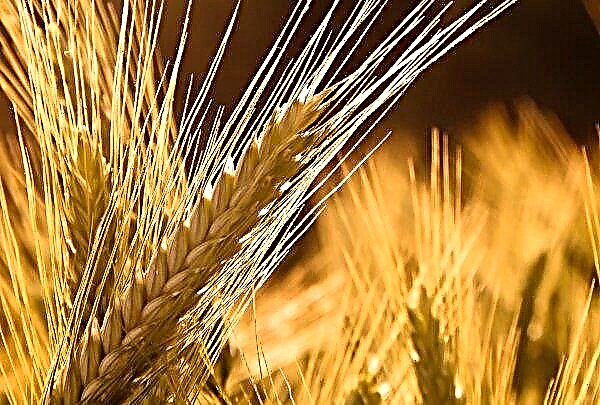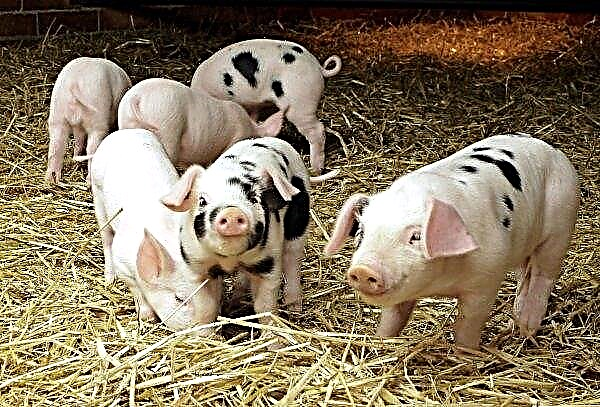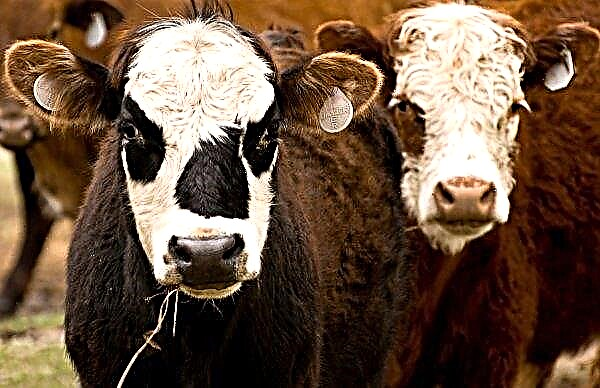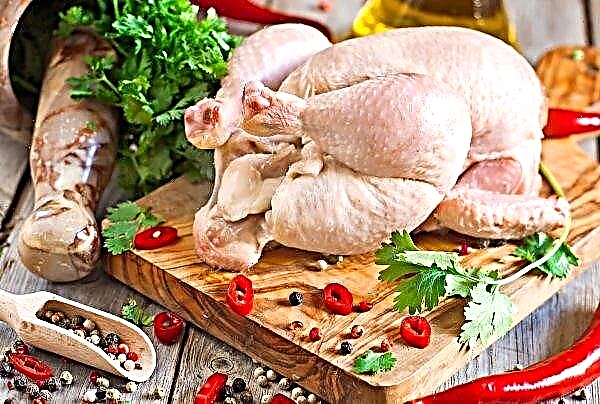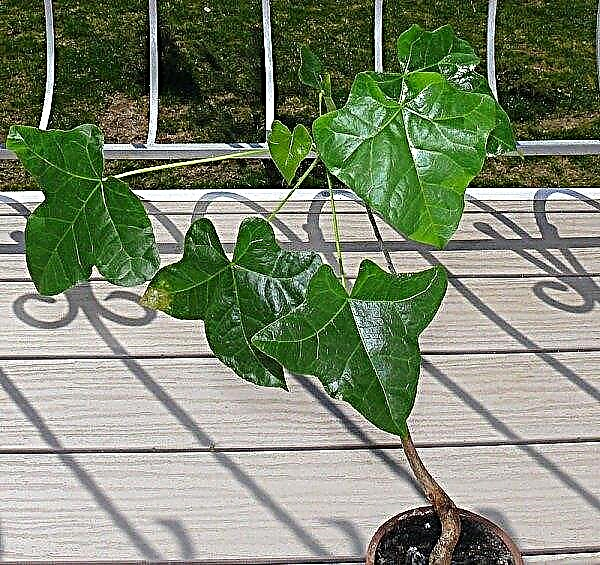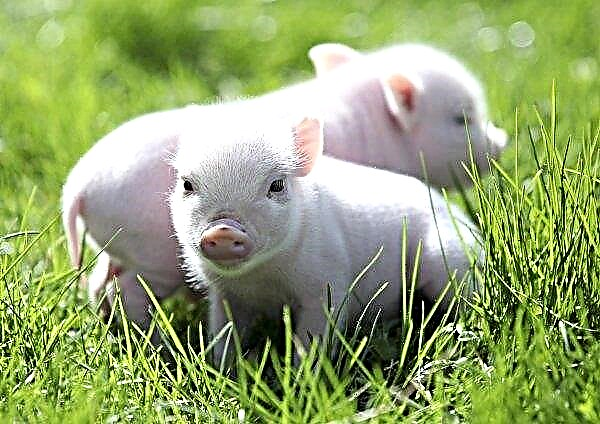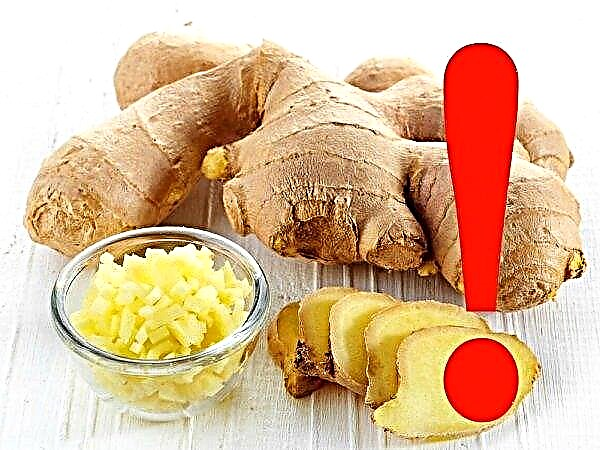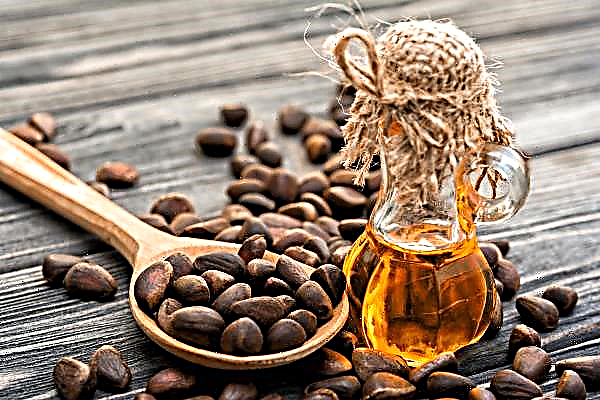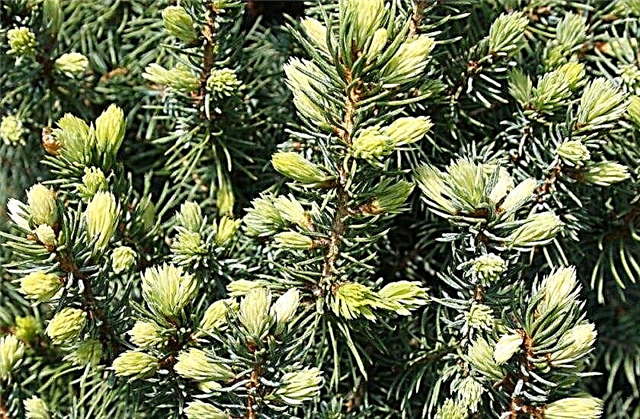Kuban red is a representative of the egg type of chickens. Birds are distinguished by early maturity, good egg laying and unpretentiousness in the content. Well-adapted to the temperate climate, Kuban chickens can breed both large farms and small private farms.
The history of the breed
The Kuban red breed is a highly productive cross breed bred in Russia in 1995. The breeder is the Labinsky plant, Krasnodar Territory (Kuban). The purpose of selection: the creation of a highly productive autosex egg cross-country, well adapted to a temperate climate.
In the creation were involved:
- the most productive egg breed leggorn white (Italy)
- meat-and-egg breed of rhode island (USA) with a characteristic plumage of dark brown color.
The new breed combines the best features of its predecessors.
Important! Kuban hens are cross-country. To maintain breed characteristics, cross-breeding is carried out on an industrial scale plant. In a small farm, maintaining productivity at a given level is difficult, so small farms practice the purchase of hatching eggs.
Description of Kuban chickens
Kuban red hens are perfectly prepared for life in a temperate climate. They are unpretentious in nutrition and maintenance, almost do not get sick and are characterized by good survival of offspring.
The nature of the Kuban chickens is peaceful, they easily get along with other inhabitants of the houses. The breed is distinguished by high stress resistance, due to which laying layers maintain high productivity regardless of circumstances.
Appearance characteristic
The breed is autosexual, so chickens can be distinguished almost from infancy: males are light yellow, hens are fawn.
Productive qualities
Modern breeders do not set the task of simply breeding new breeds, but obtaining chickens with high productivity and low costs per egg. And Kuban chickens meet this requirement.
Hens travel regularly until late fall. The peak egg production is the first 2 years, after which productivity declines. Egg weight also varies. Young chickens have less eggs, but they have better taste and are more useful in composition.
In order for productivity to be high, it is necessary to ensure the correct temperature regime (not lower than 18ºС). At the time of formation of the reproductive apparatus in the diet should be a lot of calcium and vitamins. High-quality nutrition guarantees good productivity.
Character
Kuban chickens are calm and non-judgmental - this applies not only to layers, but also to males. They do not conflict with other birds. It is likely that birds owe their calm to genetic selection, as well as to the fact that hens of egg breeds are usually low-conflict.
A very important advantage of kubanoks is that they are not at all timid. Therefore, the chicken coop and paddock can be in a noisy area without compromising bird productivity.
Important! It is not recommended to keep them together with larger, more aggressive birds (fighting chickens or turkeys) due to the light weight of Kuban hens.
Advantages and disadvantages
- Advantages of the breed:
- high productivity - about 300 eggs per year;
- early maturity and peak performance after 180 days;
- the period of maximum productivity is about 80 weeks;
- good survival of young animals;
- livable character;
- stress resistance;
- quick adaptation to new conditions;
- the ability to distinguish the sex of chickens from a minimum age.
- The disadvantages of the breed:
- it is difficult to maintain the productive qualities of crosses when breeding in small farms;
- after 150-180 days from the beginning of the laying of eggs, the productivity of laying hens begins to decline and in a year will fall to 60%;
- light weight;
- meat of egg hens is not juicy enough.

Features of care and maintenance
Care includes taking care of proper nutrition and conditions. Kuban chickens can be kept in cages (on large farms) or on the floor (on small farms). With the floor content, planting density is 6–8 chickens per square meter. m
The house should be light enough. The daylight hours should be at least 14 hours in order to maintain productivity at a high level.
Regular litter replacement and periodic chicken house disinfection for disease prevention is required. To prevent diseases - it is necessary to regularly disinfect the chicken coop, exclude contact with wild animals and maintain quarantine for birds that are acquired after the main herd.
Adult layers are fed 3 times a day.
In their diet should be present:
- cereals;
- concentrated feed;
- roots;
- greenery;
- minerals.
 Access to water should be continuous.
Access to water should be continuous.Kuban hens can do without walking and be kept in cages. But walking allows birds to supplement their diet with nutrients. So, the eggs of chickens that go on a paddock contain more nutrients.
Chicken coop requirements
The house is set so that winds do not affect indoor temperature. It is desirable that from the north it was covered with trees. The chicken coop should not stand in a lowland with closely lying groundwater.
For productive keeping of chickens, humidity, temperature and gas contamination of the house are important.
- For kubanok optimum temperature is 18ºС. At temperatures below 14 ° C, hens are carried less frequently, therefore, to maintain egg production, the house must be insulated.
- Relative humidity should be at the level of 60–70%. In autumn and winter, humidity can reach 90%.
- For the birds to feel comfortable, good ventilation is needed. Natural ventilation is organized by supply and exhaust pipes. If it is not enough, then install a fan. Together with excess humidity, it will quickly remove excess ammonia from the room.
 Replace contaminated bedding every 3 days or as it becomes contaminated. Feeders and drinkers are cleaned daily, especially after wet feed. Disinfection is carried out 1 time per quarter. If a sick bird is detected - on the same day.
Replace contaminated bedding every 3 days or as it becomes contaminated. Feeders and drinkers are cleaned daily, especially after wet feed. Disinfection is carried out 1 time per quarter. If a sick bird is detected - on the same day.Illumination affects the productive qualities of chickens. Daylight hours of hens should last about 14 hours. To achieve this, artificial lighting is required in the winter.
The chicken coop floor is covered with dry litter of hay, straw, dry leaves. The optimum layer thickness is 0.2 m. The nests are installed at the rate of 1 nest for 5 layers. Size - 30 x 30 x 35 cm. Perch poles are made of bars with a diameter of 4-6 cm, so that it is convenient for the bird to grasp the roost with its paws. The height of the perches is at least 1.2 m.
Important! Daylight hours of chickens should never begin before 4 in the morning - in accordance with the natural biological cycle.
Walking yard
The need for walking for chickens is required. The courtyard is fenced with a net or a wooden fence; at a height of not less than 1.5 m it is pulled up with a net to prevent contact with wild birds and predators. The walking area for 1 layer is at least 1 sq. Km. m
It is advisable that part of the walking area be shaded from the sun. Here you need to install 2 feeders - for wet and dry food and a drinker.
Feeding troughs and drinking bowls
In a tank for drinking water should be at least 5 liters. It can be either an ordinary bucket or a vacuum or nipple drinker. Water must be fresh. The optimum temperature is 20ºС.
The feeders should be long, box-shaped.
Production Material:
- plastic;
- metal;
- wood.
The feed zone for 1 bird is at least 10 cm. To prevent chickens from raking food, feeders are installed at a height of 15 cm from the floor.
Important! Water with a high content of metals causes problems with the kidneys, and too hard water is manifested in the form of violations in the development of the shell (uneven, with tubercles). To reduce the level of contamination, use purified water.
Diet
A lot of factors influence feed intake:
- weight of poultry;
- productivity;
- air temperature;
- feed particle size;
- energy fullness.
 The feed mixture should be of a homogeneous structure. The size of food particles is not larger than the granules in industrial feed for optimal assimilation. If the feed is too small, the bird will eat less and will receive less nutrients.
The feed mixture should be of a homogeneous structure. The size of food particles is not larger than the granules in industrial feed for optimal assimilation. If the feed is too small, the bird will eat less and will receive less nutrients.Feeding should take place in 3-4 doses. In the morning and in the evening, hens get grain, and in the afternoon they are given mixers, green and concentrated feeds.
Did you know? A fresh, freshly laid egg has a maximum weight of 50-60 g on average. As it is stored, the weight decreases due to a decrease (drying) of the protein volume. Therefore, an egg is considered to be very useful and medicinal only for 7 days, and then it is called a dining room and is used only for culinary purposes.
In winter
In winter, Kuban chickens need more grain and less green feed. The daily feed weight is 120 g. The lack of greens can be made up for with grass meal and yeast feed.
The daily winter diet should include:
- salt and chalk - 5-6 g;
- grass meal - 10 g;
- animal protein - 50 g;
- meat and bone or fish meal - 2 g;
- root crops - 150 g;
- oilcake - 10 g;
- grain - 50 g;
- Hookers - 30 g.
Hay is added to the diet. But root crops are recommended to boil and give in chopped form.
In summer
In summer, greens are present in large quantities in the diet. The daily feed rate is 150 g. In the summer, feeding on walking is of great importance - this gives an additional amount of fortified greens and protein foods (beetles, worms). Walking can provide the bird with about 30-40% of the diet. The daily summer diet includes:
The daily summer diet includes:
- salt and chalk - 5-6 g;
- animal protein - 10-15 g;
- meat and bone or fish meal - 2 g;
- green food and root crops - 50 g;
- grain - 50 g;
- concentrates - 50 g.
Did you know? The correctness of the diet is easy to notice from the litter. A dense litter of dark color with a white coating is a sign of a well-balanced diet.
Herd replacement planned
Although chickens can live for more than 10 years, when raising poultry to get eggs, a planned replacement of the herd is made after 2 years. It should be remembered that with age, egg production decreases, so that the content of birds that lay fewer eggs will be unprofitable.
Shedding and age problems
In nature, the peak egg laying in chicken falls in the spring and summer. Autumn is the period of preparation for winter; at this time, seasonal molting begins, which is associated with a change in daylight and the rhythm of life. If the molt passes correctly, then it will end in 1-2 weeks. If the process drags on, the birds need help. In terms of chemical composition, a feather is a protein. In order for the new feather to appear quickly, you need to provide the chicken with a large amount of protein and a balanced diet - this will reduce molting time. Protein is found in cottage cheese, skim milk, meat and bone meal, fish.
In terms of chemical composition, a feather is a protein. In order for the new feather to appear quickly, you need to provide the chicken with a large amount of protein and a balanced diet - this will reduce molting time. Protein is found in cottage cheese, skim milk, meat and bone meal, fish.
How to raise chickens
Before placing chickens in the house, make sure that the humidity and air temperature are in compliance with the normative ones: humidity - 60–70%, temperature 35–36ºС. Chickens need constant access to water and feed. The floor of the brooder is covered with paper, which is replaced daily.
Proper feeding
A balanced diet ensures the health of the chickens and their good development. In poultry, there are 2 varieties of chicken diets: natural nutrition and industrial compound feeds. Both points of view have their supporters and opponents. If you don’t have enough time to prepare feed, feed the chickens with compound feed.
Approximate scheme:
- compound feed "Start" - from birth to 3 weeks;
- compound feed "Fattening" - from 3 weeks to 3 months;
- “Finish” compound feed - for adult hens.
The daily rate for birds of different ages is indicated on the package. Feed the chickens at least once every 2 hours. If the chickens are fed natural food, then the diet will include:
If the chickens are fed natural food, then the diet will include:
- 1-2 weeks - boiled egg, cottage cheese, millet, boiled carrots, plantain greens;
- 3-4 weeks - add boiled beets, fishmeal;
- Weeks 5–6 - remove the egg from the diet and add the sprouted grain, crushed corn, and wheat.
The number of feeds changes gradually. In the first 2 weeks you need to feed the chicks 8 times a day. Every 2 weeks, the number of feeds is reduced by one, and by the end of the second month, chickens are fed 3-4 times a day.
The amount of food received will also gradually increase, increasing by 5-10 g per week. Access to water should be continuous. Water temperature in drinking bowls should not be lower than 20 ° С.
Chickens should not be given:
- dirty or rotten vegetables;
- meat and smoked meats;
- sweets and buns;
- food leftovers from people's table (due to the high content of fats, salt, sugar, spices).
If Kuban chickens eat compound feed, then the content of vitamins is indicated on the package, so it is convenient for the farmer to control their amount. With a lack of vitamins in the pharmacy, additional drugs are purchased - vitamins C and D, which are evaporated to the birds along with water.
Vitamin C is essential for birds to prevent colds, and vitamin D is essential for bone formation and the reproductive system. During the period of growth and active oviposition, attention should be paid to the fact that:
During the period of growth and active oviposition, attention should be paid to the fact that:
- with growth retardation - you need to add vitamins A, D to the diet;
- with poor quality of feather cover - add vitamins A, E;
- with a drop in egg production - vitamins A, D, B2 are required;
- pale yolk is a lack of vitamin E;
- thin shell - a lack of calcium and vitamin D.
Did you know? Roosters have wonderful memories. They are able to remember about 100 people or animals. This property allows the cockerel to distinguish its chickens from strangers and remember the offenders.
Care
The health of the chicken depends on various factors - this is nutrition, and environmental parameters, and timely vaccination.
So that in the first days of life, chickens do not suffer from hypothermia, their brooder should maintain a temperature of at least 33 ° C in the first week of life. With each next week it decreases by 2 degrees. Relative humidity remains at the level of 60–70% constantly.
When using the ventilation system, make sure that there are no drafts in the house.
If the chickens gather crowded at the heat source - it means they are cold, and the air temperature needs to be raised. But if they disperse, ruffle feathers and lie down, then it is hot for them, and the temperature needs to be lowered. In the early days, house lighting should be constant. Then it is advisable to divide the day into phases of rest and activity according to the following scheme: 4 cycles, which consist of a 2-hour sleep (without lighting) and 4-hour wakefulness (the light is on). The reference point is the biological day for chickens - at 4 a.m.
In the early days, house lighting should be constant. Then it is advisable to divide the day into phases of rest and activity according to the following scheme: 4 cycles, which consist of a 2-hour sleep (without lighting) and 4-hour wakefulness (the light is on). The reference point is the biological day for chickens - at 4 a.m.
The advantages of such a scheme are that:
- chickens are synchronized - all actions become simultaneous;
- weaker chicks are stimulated by stronger ones to increase activity;
- survival of chickens increases;
- it is easier for the farmer to control the growth parameters of the stock.
As you grow, the duration of daylight hours will change. For the correct development of chickens older than 1 month, it is necessary to organize a walk. It should be isolated from contact with other birds or animals and well lit. Organized constant access to food and water on a walk.
Vaccination
Vaccination is an effective way to prevent disease. The vaccination schedule depends on the system adopted in the region. It is carried out only for healthy chickens. Vaccination is necessary to create immunity to bacterial and viral effects.
Most vaccines are weakened or killed microorganisms, pathogens. As soon as they enter the body, the immune system begins to produce special antibodies.As a result, the vaccinated chicken becomes immune to disease. Vaccination is carried out:
Vaccination is carried out:
- aerosol spraying;
- instillation of the drug;
- intramuscular injection.
The method of use depends on the form in which the drug is produced. Chicken products are usually instilled into the beak or drunk along with drinking water. After the procedure, the activity of chickens for some time may decrease - by 3-5 days after vaccination.
If you notice that the chicken has become painful, passive or has other signs of malaise - isolate it from the rest of the herd and invite a veterinarian.
The vaccination program includes:
- Vaccination of IBC in the form of a spray or desoldering immediately after birth and every 7-10 days according to the scheme; the main drug is the Bioral vaccine.
- Prevention of mycoplasmosis and bacterial infections by drinking in the first days after birth and on the 20th day; main drugs - Vitrocil, Doxin 200, Macrolan.
- Stress prevention on the 5th and 25th day in the form of drinking; the main drug is Hydrodex vital.
- Prevention of salmonellosis and colibacteriosis on the 12th, 20th and 30th day; the main drug is Eripim.
- Vitaminization on the 17th day; the main drugs are vitamin C, other complexes as prescribed.
Important! Aerosol spraying is convenient if you need to handle a large number of chickens. It is necessary to spray the bottle from a distance of 15–20 cm. It is impossible to direct the stream at the head of the chicken.
Common Cuban Disease
Kubanok, like other birds, can be exposed to germs and viruses, mechanical injury, environmental influences, or conditions of detention. Treatment depends on the nature of the disease. The main signs of the disease:
The main signs of the disease:
- the chicken is inactive and not active;
- not in contact with others;
- seeks to find a secluded place;
- feathers are tousled or there are bald patches;
- eyes are dull;
- decreased or absent appetite.
In infectious diseases, discharge from the eyes or nose, diarrhea, inflammation of the mucous membranes can be observed. Sick birds are isolated from the rest of the livestock. The course of treatment is determined by the doctor according to the diagnosis.
Infectious diseases
Infectious diseases are caused by bacteria or viruses entering the body. They are transmitted from one bird to another through common household items, walking areas, etc. The causative agent can also get into the house along with rodents or blood-sucking insects.
Diagnosis of infectious diseases is performed only in laboratory conditions, since most of the external symptoms are common to all infectious diseases, and nonspecific characteristics are revealed when examining scrapings of the mucous membranes, and a biochemical blood test.
The main infectious diseases:
- paratyphoid;
- smallpox
- Newcastle disease;
- tuberculosis;
- mycoplasmosis.
To prevent infectious diseases, birds need to be vaccinated on time, hygiene indoors and quarantine for newly acquired birds. If a diseased chicken is identified, it is isolated from the rest of the herd and the veterinarian seek help. When confirming fears, the doctor prescribes treatment for the diseased bird, vaccination of the rest of the livestock, and disinfection of the house. There is no effective treatment against some diseases - in these cases, sick birds will be disposed of.
When confirming fears, the doctor prescribes treatment for the diseased bird, vaccination of the rest of the livestock, and disinfection of the house. There is no effective treatment against some diseases - in these cases, sick birds will be disposed of.
Important! Some infectious diseases of birds are transmitted to humans. - nFor example, typhoid. Therefore, identifying a sick chicken, follow preventive measures and hygiene. Wear special clothing and gloves.
Parasitic
Parasitic infestations are common among chickens quite often. It can be helminths that enter the body from contact with soil, grass, earthworms. Or skin parasites - ticks, fleas, lice. To prevent infection, chickens organize an ash bath.
Characteristic signs of worms:
- anxiety;
- sudden weight loss;
- growth retardation;
- dirty feather in the cloaca area.
In the presence of skin parasites in places of bites, severe itching occurs, the bird becomes nervous. The area affected by skin parasites becomes inflamed, and a feather may fall out on it. Lice and fleas are diagnosed visually, and ticks by the prolapse of the pen.
Treatment consists of taking insecticides and anthelmintic drugs. The peculiarity of the reception is that after 7 days after the first treatment, the reception is repeated. This technique destroys first the active parasites, and then those that have hatched from the laid eggs.
Non-communicable chicken diseases
Non-communicable diseases result from poor-quality conditions of detention. Such diseases do not have common symptoms and are treated separately.
- So, hypovitaminosis is associated with a lack of vitamins in the body. It arises due to the lack of any feed: protein food, herbs, root crops, etc. The treatment consists of changing the diet - add coniferous flour, carrots, greens to it.
- As a result of poor-quality feed intake, digestive upset occurs.
- Drafts or hypothermia will cause the development of viral infections.
Treatment of non-communicable diseases is selected depending on the diagnosis. But in addition to treatment, you will also need to eliminate the cause of the disease.
Friendly Kuban chickens have good immunity and with good nutrition and good care give up to 300 eggs per year. This is very beneficial for farming. Good adaptability to environmental conditions allows people to support them without special bird handling skills.


